ISSN ONLINE(2319-8753)PRINT(2347-6710)
ISSN ONLINE(2319-8753)PRINT(2347-6710)
Mansour Momeni1, Mansour Soufi2, Mehdi Ajalli3
|
| Related article at Pubmed, Scholar Google |
Visit for more related articles at International Journal of Innovative Research in Science, Engineering and Technology
Layout planning of machinery and equipment is fundamental problem in each plant. The aim of layout method of machinery and equipment and offices is layout planning of manufacturing machines and stations, offices in different parts of manufacturing and service organizations. If all of products are the same, factory layout planning will be relatively easy; the problem starts when products are various and each will have its manufacturing process. Nowadays the concept of customization manufacture or mass customization replace to traditional methods of mass production. In order to overcome the complexity of custom manufacturing that potentially to be created in system of manufacturing, can used way for making cell to divide small and manageable parts. In layout of cell is usually used production flow analysis technique for cell classification; this paper presented a methodology based on clustering processes for layout planning of different products. The steps proposed of this methodology is presented that focuses on the data conversion with the most information algorithms to establishment of equipment and based on to calculate similarity coefficient, manufacturing cells are formed.
Keywords |
| Layout Planning, Mass Customization, Data Clustering. |
I. INTRODUCTION |
| Nowadays market has special position that further complexity is added each day. There are complex demands and specific needs of design to achieve the standard framework makes it very difficult. In order to achieve the needs of the market, following the pattern of cell design has great importance [2]. Using a cellular strategy to produce all types of products and fast delivery to customers is an integral part of contemporary management thinking [3]. Cellular system has layout capabilities, divisions and different use and can be easily extended. Create multiple products by using limited resources creates stiff competition in the manufacture of goods. If a company seeks to rationalize manufacturing facilities and to produce various products at low prices, should consider ways to make cells [4]. Nowadays the custom manufacturing and or mass customization replace traditional mass production techniques [5]. Mass customization, mass production of goods and services are customized for each individual. The goal of mass customization production is producing goods and services with sufficient diversity; in this case each customer can buy a customized product that its cost is close to the cost of mass-produced products. In other words, mass customization will give exactly product that the customer needs it, and at a cost that s/he wants, when s/he wants [6]. |
| Place of research is Shoae Beton Shargh Company. The main issue of research is new layout and installation of production lines and machines in defined place in firm position space. In this paper, by using clustering techniques offers specific methodology for automated layout planning of machinery and equipment manufacturing based routing of each product. When the products are not detectable as mass and production volume is low and variety of products is very high, one of the problems in the production system is the allocation of products to manufacturing cell in a group technologies. Research methodology allowed the identification of appropriate layout planning for each product, regardless of the production volume. Information needed to implement the methodology obtained from routing information in production of product and it doesn’t need for information gap, cycle time, flow rate, and other resources |
| that their collection is consuming and expensive. Thus after basic concepts in theoretical framework explain the problem and its solution; accordingly algorithm is proposed to solve such problems. |
II. 2. THEORETICAL FRAMEWORK |
| a. Mass Customization |
| Mass customization predicted as Future Shock by Alvin Toffler in 1970 and in 1987 was marked by Stan Davis as complete future. Mass customization is a new way of competing commercial and method to identify and to complete the wants and Critical needs of individual customers, with regard to efficiency, effectiveness and low cost [7]. Mass customization is performed in four steps. One of competitiveness challenges of companies producing customized products in a mass scale is creating a range of solutions (figure 1). |
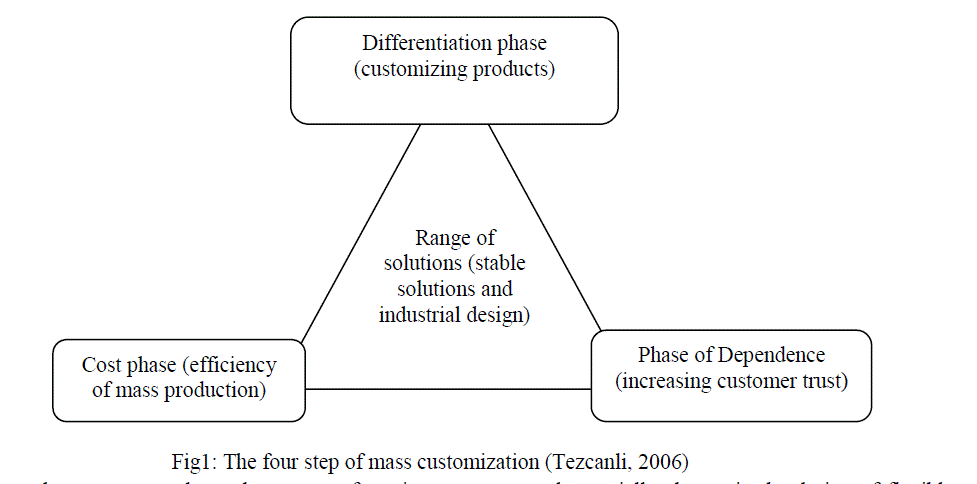 |
| To achieve such a system needs to change manufacturing processes and especially change in the design of flexible processes. When all the products are the same, layout planning is relatively easy, the problem starts when products are different and each one will have its own manufacturing process. A family of products, the amount of variation in the final products depends on customer's choose options. In level of production, such diversity requires a very complex control operation and manufacturing. When want to create diverse sets with different numbers of different products, layout of the equipment and machines and how the transport materials or transport equipment will be one of the main concerns and issues [9]. |
| b. Plant Facility Layout |
| Facilities may be a machine tool, center service, cell manufacturing, machine workshop, department, store and each part. Facility layout is an arrangement and order of everything that is necessary to produce goods or provide the services [9]. In fact aim of this study is facility layout to minimize delays in material handling, supply flexibility, more efficient use of space and labor and to increase employee morale. Proper facility layout has an impact in overall operational efficiency and can even reduce50 percent of operating expenses and also can increase amount of an organization's products and services [10]. |
| c. Similar Criteria for the Combined Scale [11] |
| To measure the similarity between two objects or between two clusters, we use a general similarity coefficient that First, by Gower (1971) were presented. General coefficient of Gower for dissimilarity of two objects X and Y are as follows |
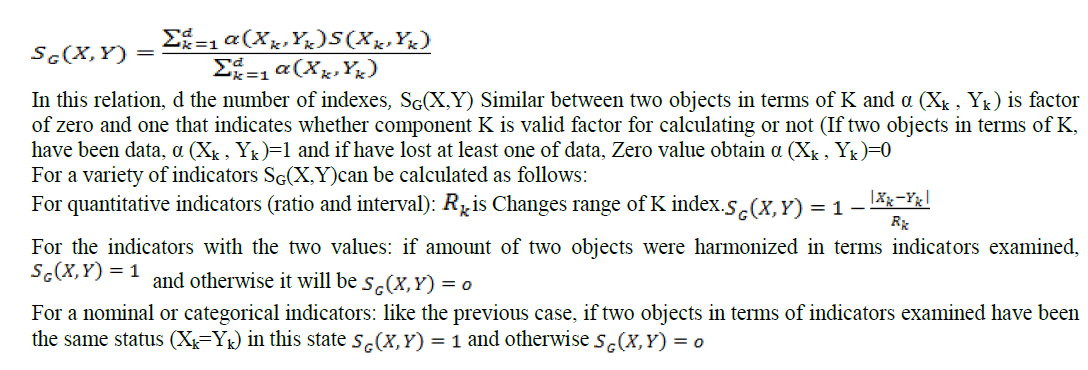 |
| d. The Center of Gravity Method [12] |
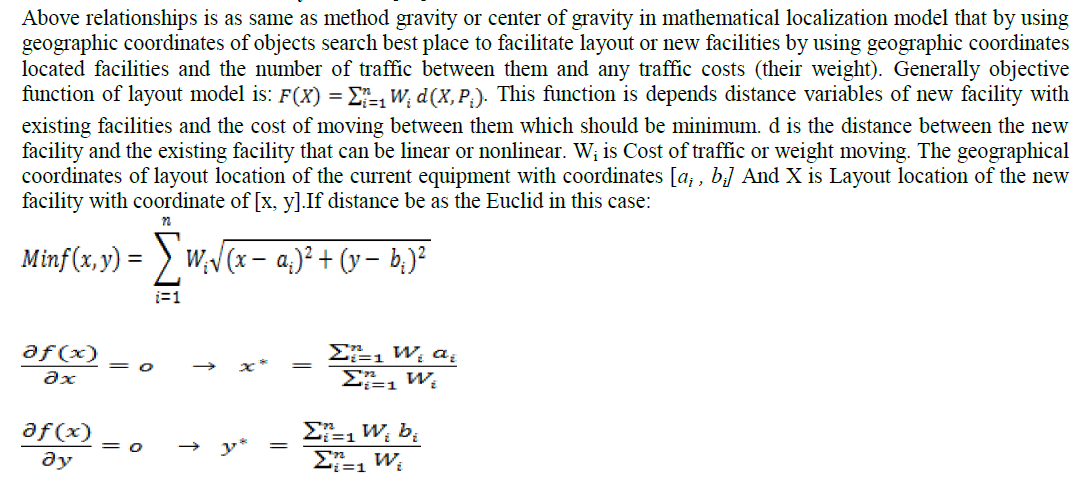 |
III. 3. STATEMENT OF THE PROBLEM |
| Company Shoae Beton Shargh use mass Customization systems and it produces products with minimum numbers, but a great variety based on customer order. This Company has Established machines (M1 , M2……..Mn) that each collection is dedicated to making a series of products. Each production process is unique to one product family and is different with other production process; there isn’t also mass production and each family has its own custom product that are low number but diverse. To illustrate the problem, consider only part that makes the product family of lamp base. List of products and production processes in these families is presented in (Table 1). |
 |
| As can see, some of the products from one machine pass in their manufacturing processes. B1025 product in a stage of its production of the machine 5 (M5) passes and B1028 product in a stage of its production of the machine 5 (M5) passes. Thus, relevant information can be extracted to provide a layout planning. It is clear that if number of products be high, to get an overview of information will be difficult; in opinion of investigator in such cases the use of clustering algorithms (cluster analysis) is desirable. Cluster analysis is an attempt that observations in each cluster (group) have been most similar together in terms of variables of interest and observations of each group has been maximum distance from other groups’ observations [11]. |
IV. LAYOUT METHOD OF MANUFACTURING CELLS BY USING CLUSTERING TECHNIQUES |
| In a method that is introduced, layout is built based on categorizing the pieces of the product family. First process is classified and similar processes are in one group. Then for each group, a cell is considered. This method combines the benefits of the product deployment and workshop by using data clustering techniques that that technique of industrial cell layout planning is easier and less costly; because is not requiring information the flow of material or the direction and acts based on path of product manufacturing. |
| a. Family Members Identify of Products |
| To identify members of a product family based on the similarity of the products should be considered the criteria. In opinion of researchers in a group technology [GT] can use separate algorithms matrix of clustering data that are known to non-hierarchical methods and methods of oriented center because these techniques are used to problems that the number of objects or numbers index or both are high. [11]. |
| This research has focused on methods of data clustering. Clustering (also called segmentation) population divides into smaller sub-populations with similar behavior based on a standard predefined. Clustering based on maximum uniformity will be in each cluster and the most non-uniformity among clusters [13]. For using the data clustering method, in first step of data (Table 1) based on the similarity of use of the machine was converted and were modified that is Led to the formation Table 2. |
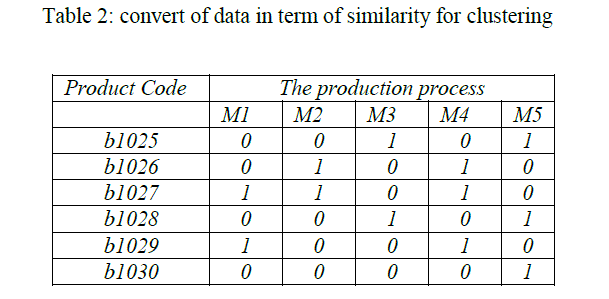 |
| 1) This table is composed based on the similarity of a passing each group of products machine and based on the principles of clustering for quality measures that the similarity with the number (1) and dissimilarity of number (0) coded. Accordingly, we could calculate the similarity coefficient because by using it obtained the adjacency matrix and create the clusters (primary cells). Calculations was performed based on similar relations from general similarity coefficient in reference [14] |
 |
 |
 |
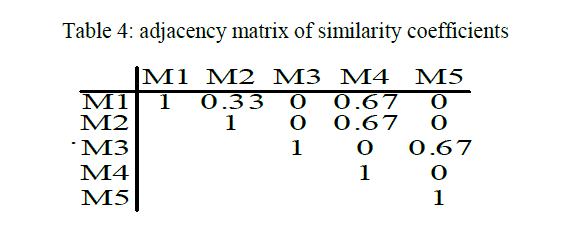 |
| Based on the similarity matrix was done primitive clustering mechanisms (Table 5); and based on machines clustering were defined clustering of products, and family of products (Table 6). In this way machine (1 and 2), (1, 4), (2, 4) and (3, 5) which has a similarity coefficient that can be deployed side by side and machinery (1, 3), (1, 5), (2, 3), (2, 5), (3, 4) and (4 and 5) should not be deployed together. This concept formed the basis of the relationship diagram between activities (Activity Relationship Chart) or ARC that expresses the importance of each machine in the side of other… |
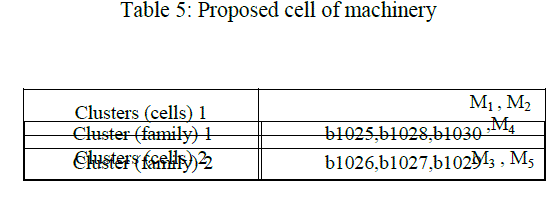 |
| Based on primitive machining cells can also deal with clustering of products |
 |
| Assuming producing cells (Table 5) are valid [11]; in this case, the right Layout of primary cells circulating products among the cells was analyzed. |
| thus the distance between machines, material flow rate and material handling costs and also the relationship between human and machine for production support or maintenance and repairs, were analyzed from different angles; so instead of moving of products from one machine to another machine (Table 1), cell-to-cell movement (Table 7) were studied to establish the most appropriate machinery. |
| With the integration of Table 1, 4 and 5, the following results were observed: |
| Table 7: The process of manufacturing machine-cell |
| In this way overall layout planning of machinery in an assembly line based on group technology can be consider as a table (7): |
 |
| b. Recognition of Manufacturing Processes Related and Making Cell |
| In the first stage all equipment belonging to specific cells and its cells were placed next to each other. So it considering the arrangement associated with each product within each cell, the displacement was consistent with cost minimization. The main goal is identifying the relevant production processes per cell (Tables 8 and 9) the separation and machinery deployed in the right place. |
 |
| As a result, layout by the straight line (without moving return) and was performed in 2 cells that related product family also identified. Care must be that each cell be intended machinery required for the manufacture of products. In some cases, a couple of family of products need to basic machine for their products. In such cases, managers must analyze the cost - benefit, or a separate machine for each cell establish or share a machine between two cells that In this case is created limit and will need to schedule production. |
V. ALGORITHM TO LAYOUT OF MASS CUSTOMIZATION PROCESSES WITH CLUSTERING METHOD |
| According to what was described, algorithm to problem solution of layout of mass customization processes (Figure 1) is proposed: |
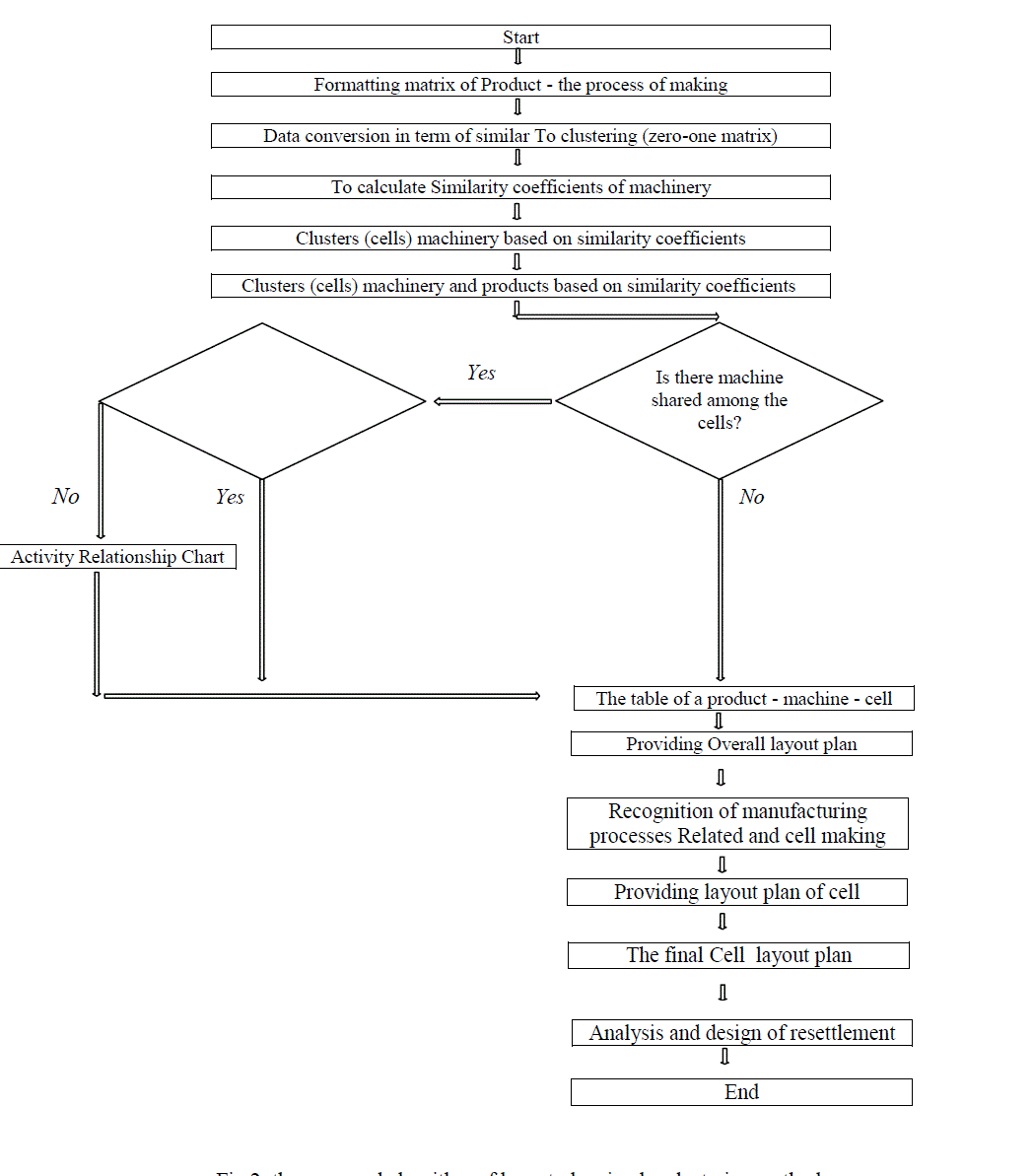 |
 |
VI. CONCLUSION |
| For classification of cells, manufacturing processes in group technology is usually used the method of production flow analysis. In this paper by using clustering techniques offers a methodology for automated layout planning of machinery and equipment manufacturing based routing of each product. When the products are not detectable as mass and large and production volume is low and variety of products is very high, one of the problems of production system is associated of products for manufacturing cells in group technology. The methodology of this study allowed the identification of appropriate layout planning for each product, regardless of the production volume. Information needed to implement the methodology can be obtained routing information of product and doesn’t the need for information flow rate, cycle time, and other resources of time consuming and costly. |
| Important to note is review of layout planning process. It is possible that new cells cover the old cells. The distinction cause the proposed algorithm is automatic layout of new facilities and automatic membership for new products in family of products. This paper is underlying to investigate other clustering methods in the layout planning and based on can use to make fuzzy cell and providing layout planning with information related to start-up costs and prepare |
References |
|